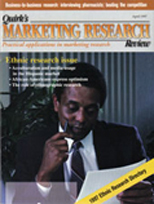Your prescription is ready
You may not have heard of United States Pharmacopeia (USP) but you're probably glad it exists. That aspirin you took yesterday? USP helps make sure it's manufactured to uniform standards of purity.
Founded in 1820, USP is a private, not-for-profit organization in Rockville, Md., made up of over 1,500 volunteer health care professionals, scientists, academicians and government officials. Among its many activities, USP sets the standards for drug packaging, purity and quality - which the FDA enforces - and provides drug information to doctors, pharmacists and other health care professionals and the public.
One of the main information sources it provides is USP DI Volume I, Drug Information for the Health Care Professional, a book of data on drug dosages, interactions, side effects, brand names, generic names, etc. Pharmacists subscribe to the book, which is issued annually and updated monthly. (Many states require pharmacists to have a copy of USP DI Volume I, or another drug reference source, on hand. Some specify the USP DI Volume I and others offer a list of acceptable substitutes.)
While such a tome (the 1997 edition runs 3,360 pages) is a natural for issuing on CD-ROM, until recently USP has only offered a print version, letting other licensed vendors incorporate USP's drug information into their own CD-ROM products. But in April, USP's CD-ROM version, called USP DI Plus, is scheduled to debut. "We wanted to enter the electronic age," says Joan April, category manager, drug and therapeutic information, USP.
Confirm assumptions
Feedback from USP DI subscriber surveys, focus groups and research conducted at trade shows indicated interest in a CD-ROM version. But like any smart marketer, USP decided to confirm those assumptions by talking to prospective buyers.
Past mail surveys, including one inserted in the 1995 edition of USP DI Volume I, had drawn low response rates, April says, so USP decided to go with telephone interviews. With the help of Woelfel Research, Vienna, Va., pharmacists at hospitals, chain drug stores and independent drug stores who subscribed to the print version of USP DI Volume I were contacted.
Information from the research helped USP prioritize the features it emphasized in marketing USP DI Plus. "We wanted to assess their perceptions of the content of the product because we had some options about what we could add to it," April says.
Respondents were told that USP was conducting the research to get their reactions to a new product. "We gave them a basic briefing on the new product and gave them a list of potential new features and asked how useful they thought they would be," says Jeff Adler, vice president of Woelfel Research. "We told them about new features being considered for the CD-ROM version and found varying interest in them. But the features in general increased interest in the new product."
The rest of the survey touched on satisfaction with other USP products, pricing, purchase intent, awareness of competitors' products, possible names for the new product, and familiarity with various information formats.
While CD-ROM seemed the natural choice to house all the information in the USP DI Volume I, with the growth of the Internet, USP wanted to assess the popularity of other electronic delivery approaches. The research confirmed that CD-ROM was preferable to online or floppy disks. "In addition to determining ownership or accessibility to CD-ROM players, we wanted to find out if CD-ROM was the best way to go or if they had some other electronic format that they would prefer," April says.
Biz-to-biz is different
A lot of firms fail to appreciate just how different a business-to-business interview is from a consumer interview, Adler says. "In the business-to-business research project it's important to quickly communicate to the respondent the benefit to them of participating in the study. In this case, we identified the sponsor and told the respondents that we were trying to make USP DI better and more useful to them. You have to offer a monetary incentive as a token of respect but it should also be clear that they will benefit in other ways, not just monetarily, from the research."
The research process was aided by the goodwill toward USP, Adler says. Notifying respondents that USP was the sponsor earned a high level of cooperation, which, in turn, made it possible to pay an incentive ($25) that wasn't as high as most business-to-business surveys (especially those with health care professionals) normally require.
The researchers also made sure to respect the appointments they made with the pharmacists, Adler says. "That is an extremely important point in business-to-business interviews. With a consumer, if you call them at six o'clock, they tell you to call back after dinner. With business-to-business interviews if the respondent says, 'I can't talk to you now but I can talk to you at one-thirty,' that means one-thirty, not two o'clock."
And, most important, USP resisted the urge to mix research with a sales call. The old, "while we've got them on the phone we might as well see if they're interested in buying" approach not only corrupts the research process but also may make respondents less likely to participate again in research - especially if they think a hard sell is coming after the "research" is over.
"This project did a lot of things right. USP identified itself as the sponsor of the research, contacted an audience to whom the research topic was of interest, kept the interview short and interesting, and paid them an incentive. When you do those things you can produce a high completion rate and a valid, reliable survey which has some clear, actionable answers," Adler says.
